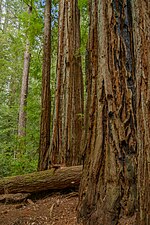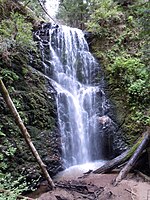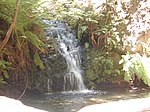Headquarters Administration Building (Big Basin Redwoods State Park)
1936 establishments in CaliforniaFormer National Register of Historic Places in CaliforniaHistory of Santa Cruz County, CaliforniaHouses completed in 1936Houses in Santa Cruz County, California ... and 5 more
Monterey Bay Area Registered Historic Place stubsNational Park Service rustic in CaliforniaNational Register of Historic Places in Santa Cruz County, CaliforniaPark buildings and structures on the National Register of Historic Places in CaliforniaQueen Anne architecture in California

The Headquarters Administration Building of Big Basin Redwoods State Park, Santa Cruz County, California, was a historic structure built in 1936 by crews of the Civilian Conservation Corps. It was built out of local materials (redwood logs and stone), and was one of the best-preserved examples of the CCC's work in the California state park system. The building continued to perform its original function, housing the park's administrative offices and serving as a contact point for park visitors, until it was destroyed by the wildfires sparked by the lightning storm of August 16, 2020. It was listed on the National Register of Historic Places in 2017, and was delisted in 2023.
Excerpt from the Wikipedia article Headquarters Administration Building (Big Basin Redwoods State Park) (License: CC BY-SA 3.0, Authors, Images).Headquarters Administration Building (Big Basin Redwoods State Park)
Redwood Trail,
Geographical coordinates (GPS) Address Nearby Places Show on map
Geographical coordinates (GPS)
| Latitude | Longitude |
|---|---|
| N 37.171944444444 ° | E -122.22222222222 ° |
Address
Redwood Trail
Redwood Trail
California, United States
Open on Google Maps




